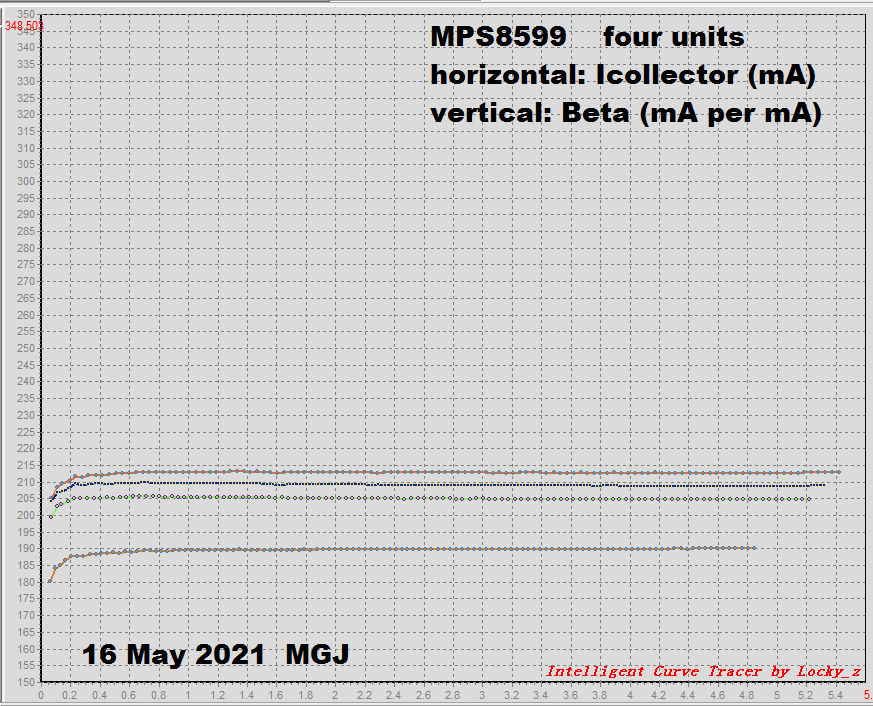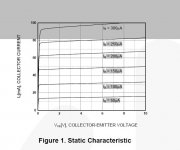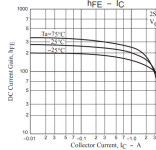If you can get hold of genuine Toshiba parts, the 2SA970, as used in Geoff Moss' variant, is a good option - I have used them for all of my JLH experiments as they have a 120V Vceo capability and almost constant high Hfe.
For Geoff's version, the emitter current to the input transistor is from a constant current source.
Regards
Mike
For Geoff's version, the emitter current to the input transistor is from a constant current source.
Regards
Mike
The graph shows the current gain 1616 starting at 10 ma collector current
Ah, got it. That graph is for Vce=2V. This chart more tells the story for line-level input, IMO.
fredbloggstwo said:If you can get hold of genuine Toshiba parts, the 2SA970, as used in Geoff Moss' variant, is a good option
I haven't come across one of those yet. I found a couple 2SA790 and for a moment thought I'd hit the jackpot, but it was dyslexia who won 🙂
I have Tosh 2SA1312, it's curves look like the Tosh 2SA1015-GR I have. I should study Geoff's CS variant.
I've very pleased with how the KSA1015-Y is performing, BTW.
Attachments
Hi again Jbau,
to save you having to ferret around, the article can be found here.
The Class-A Amplifier Site - JLH Class-A Update
and the full datasheet is attached. As I said though, fakes of the 2SA970 abound so try to get them from a reputable source if you want to try them.
Happy listening
Mike
to save you having to ferret around, the article can be found here.
The Class-A Amplifier Site - JLH Class-A Update
and the full datasheet is attached. As I said though, fakes of the 2SA970 abound so try to get them from a reputable source if you want to try them.
Happy listening
Mike
Thanks for the link, Mike. I haven't read that one yet.
So far I've gotten all of my "vintage" transistors from tearing down old Japanese industrial, computer, and consumer electronics gear, from the 80's to early 2000's. Old color crt's, early switching supplies, pre-digital consumer gear have been particularly rewarding sources, with low likelihood of fakes inside...
So far I've gotten all of my "vintage" transistors from tearing down old Japanese industrial, computer, and consumer electronics gear, from the 80's to early 2000's. Old color crt's, early switching supplies, pre-digital consumer gear have been particularly rewarding sources, with low likelihood of fakes inside...
I haven't come across one of those yet. I found a couple 2SA790 and for a moment thought I'd hit the jackpot, but it was dyslexia who won 🙂
Do you want to throw some generic 2SA970 on your curve tracer to see what they look like? I wonder if some of the low cost unbranded small signal transistors are actually generics as opposed to fakes.
Do you want to throw some generic 2SA970 on your curve tracer to see what they look like? I wonder if some of the low cost unbranded small signal transistors are actually generics as opposed to fakes.
I don't have *any* 2SA970's here, but if you want to mail them to me, I'll test it.
I have Tosh 2SA1312, it's curves look like the Tosh 2SA1015-GR I have. I should study Geoff's CS variant.
I've very pleased with how the KSA1015-Y is performing, BTW.
Hi jbau,
A1015 is my input-stage favorite too (And if by chance you have the A1015(L) that will be a killer). But I think my stock is Toshiba 2SA1015-GR. Why do you think the Y-grade (lower hfe) is better? Are they more linear? If so, I think it can't be because of the hfe but probably due to different manufacturer (KSA)?
I don't have *any* 2SA970's here, but if you want to mail them to me, I'll test it.
Sure. Send me a private message with the mailing address and I will send some to you.
Hi johnego,
Yes, in the range that is important for line-level inputs, the -Y are more linear beta. I don't have any -L to test.
Why not? If you look at the curve trace of any "graded" transistors, the lower-Hfe ones are more linear over a wider range of base currents.
I am a bit hesitant to go into too much detail about this matter in this thread, because I haven't applied it to my JLH '69 amps yet. I am doing my experiments on the JLH headphone amp, whose input stage is a little different. I "optimized" the input resistor for the KSA1015-Y last night and will be posting an update later in that ongoing thread in the headphone forum. But as a teaser, I will say that I am once again amazed at how much the sound character can be changed by simply optimizing the base current applied to the input transistor.
As a side note, on Friday I found (and then lost!) some Mot and GE 2N3906 from the late 60's to early 70's, representative of the ones JLH would have used. The Hfe's on them averaged around 100, much lower than later ones. But the GE's in particular were very linear beta over a wide range of Ib. Well suited to line-level inputs.
A1015 is my input-stage favorite too (And if by chance you have the A1015(L) that will be a killer). But I think my stock is Toshiba 2SA1015-GR. Why do you think the Y-grade (lower hfe) is better? Are they more linear?
Yes, in the range that is important for line-level inputs, the -Y are more linear beta. I don't have any -L to test.
If so, I think it can't be because of the hfe but probably due to different manufacturer (KSA)?
Why not? If you look at the curve trace of any "graded" transistors, the lower-Hfe ones are more linear over a wider range of base currents.
I am a bit hesitant to go into too much detail about this matter in this thread, because I haven't applied it to my JLH '69 amps yet. I am doing my experiments on the JLH headphone amp, whose input stage is a little different. I "optimized" the input resistor for the KSA1015-Y last night and will be posting an update later in that ongoing thread in the headphone forum. But as a teaser, I will say that I am once again amazed at how much the sound character can be changed by simply optimizing the base current applied to the input transistor.
As a side note, on Friday I found (and then lost!) some Mot and GE 2N3906 from the late 60's to early 70's, representative of the ones JLH would have used. The Hfe's on them averaged around 100, much lower than later ones. But the GE's in particular were very linear beta over a wide range of Ib. Well suited to line-level inputs.
Why not? If you look at the curve trace of any "graded" transistors, the lower-Hfe ones are more linear over a wider range of base currents.
Thanks a lot for the information. I'm shocked to find out that you are not the only one who knows about this (and I just know now!) 😱 The Toshiba looks good physically while the KSA looks like fake stuff to me (or is it?).
Last edited:
Sorry, somehow I missed your post.
That appears to be their version of the KSA1015 I suggested. I would recommend the -Y version. The -GR starts behaving more like the 992.
That capacitor (which should be NP0 or G0G ceramic, or other low-loss type) works in conjunction with the series resistance preceeding it. The -3dB frequency is 1 / ( 2 * PI * R * C). I tend to choose values in the 300-400kHz range, because AM radio starts in the low 600kHz, and there's a transmitter 1 mile from my house 🙁
Thanks a lot for your clarifications Jbau.
Soon I'll order the aforementioned CSA1015, I'm just waiting to complete a list of other stuff I need. Unfortunately the local provider doesn't mention if it's the Y version which they sell, but I'll get it anyway, wish it's the one and report here my acoustic experience.
Regards,
Domngo
I measured Ic versus Beta this morning, on a few PNP small signal transistors. The plots are in the following Forum thread, if anyone is interested:
and here is one of them, to give you a taste without having to click over to the other thread. Click on the image to see it full size and undistorted:

_
and here is one of them, to give you a taste without having to click over to the other thread. Click on the image to see it full size and undistorted:
_
That's very interesting, Mark. At what Vbe? Back in the day, the guys at PS Audio loved the 8099/8599's.
It's interesting that it doesn't "linearize" until say 300uA.
For continuity, the condensed results of my tests are now posted in the headphone forum thread:
JLH Headphone Amp
We can discuss them here, of course.
It's interesting that it doesn't "linearize" until say 300uA.
For continuity, the condensed results of my tests are now posted in the headphone forum thread:
JLH Headphone Amp
We can discuss them here, of course.
Last edited:
Answered in post #4 but I have a feeling what you REALLY want, is to gaze at the first attachment to post #2. Like most of the other plots, that one measures out better than the manufacturer's datasheet promises. Customer expectation management (?)
_
_
Attachments
Last edited:
Wow, exceptional. And in EOL last-time-buy status. Will be in my next order, thanks.
Under-promise & over-deliver builds customer loyalty, for sure 🙂 HP always did that in spades.
Under-promise & over-deliver builds customer loyalty, for sure 🙂 HP always did that in spades.
Last edited:
2SA970/2SC2240 were obsolete about 10 years ago and their replacements are SMDs. Since then, the Fairchild (now On Semi) replacements have been KSA992/KSC1845 - very similar copies of NEC 2SA992/2SC1845. These are also genuine, good quality replacement parts for the original Toshiba parts, obtainable through authorized On Semi distributors. However, what you can now buy new and marked as 2SA970 or 2SC2240, are more likely the poor copies, perhaps based on something like MPSA42/92 types, which can at least withstand high Vceo....... The Toshiba looks good physically while the KSA looks like fake stuff to me (or is it?).
Of course, everyone wants to see original part numbers and the cheaper, the better but if the current available parts marked with 2SC,2SA numbers are only sold online or by small, independent shops they will most likely be useless as very low noise transistors. Unless they are old, branded stock, and thus expensive, they will be fairly obvious fakes anyway, so why even consider them?
But it appears that there are real factories which manufacture generics. It would be nice to get some samples from one and see what the curve tracer says.
This is one example: Transistor-Foshan Blue Rocket Electronics Co.,Ltd.
I have seen this company name show up on www.lcsc.com, for example. I would like to know how good such generics are. Does anyone know? How legit are those generics?
I have also heard that sometimes little known names/subcons do manufacturing for well known names. I don't know if that happens for small signal transistors. Does anyone know?
This is one example: Transistor-Foshan Blue Rocket Electronics Co.,Ltd.
I have seen this company name show up on www.lcsc.com, for example. I would like to know how good such generics are. Does anyone know? How legit are those generics?
I have also heard that sometimes little known names/subcons do manufacturing for well known names. I don't know if that happens for small signal transistors. Does anyone know?
However, what you can now buy new and marked as 2SA970 or 2SC2240, are more likely the poor copies, perhaps based on something like MPSA42/92 types, which can at least withstand high Vceo.
Of course, everyone wants to see original part numbers and the cheaper, the better but if the current available parts marked with 2SC,2SA numbers are only sold online or by small, independent shops they will most likely be useless as very low noise transistors. Unless they are old, branded stock, and thus expensive, they will be fairly obvious fakes anyway, so why even consider them?
It's true Ian. I have experienced this many times. But these fakes (the ones with very good build quality) are not sold with cheap price, quite the opposite. But so far I can rely on smd parts like the C3324 (for C2240 equivalent) so may be the A1015 (marked BA) in smd is good too?
But my Toshiba C1015-GR are genuine old stocks.
- Home
- Amplifiers
- Solid State
- JLH 10 Watt class A amplifier

